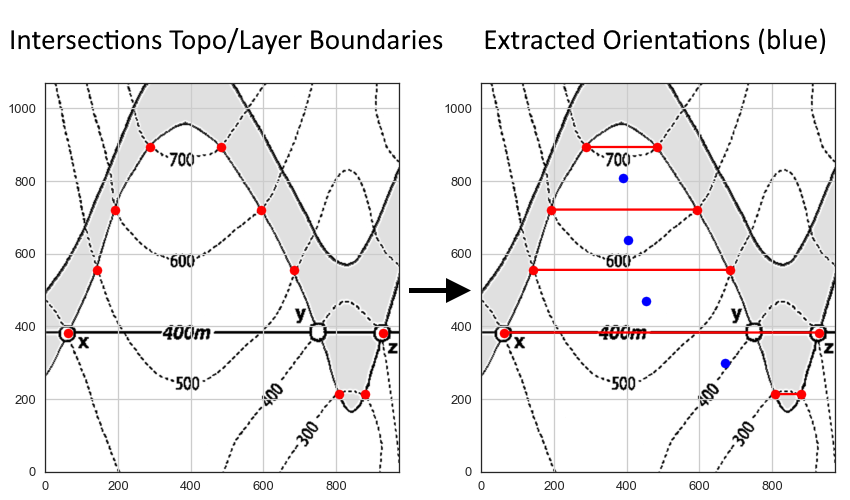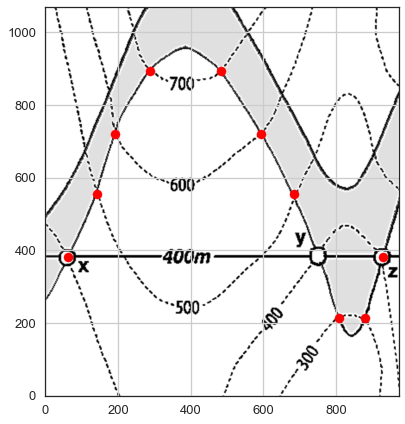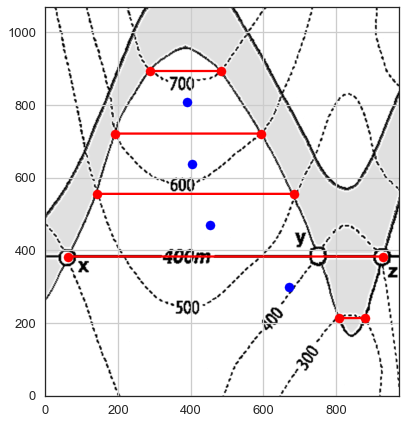29 Calculating Orientations from Strike Lines
Contents
29 Calculating Orientations from Strike Lines#
The following will demonstrate how to calculate orietations based on strike lines on geological maps. These orientations can be used to create a GemPy model.

Source: Powell, D. (1995): Interpretation geologischer Strukturen durch Karten - Eine praktische Anleitung mit Aufgaben und Lösungen, page 15, figure 10 A, Springer Verlag Berlin, Heidelberg, New York, ISBN: 978-3-540-58607-4.
Set File Paths and download Tutorial Data#
If you downloaded the latest GemGIS version from the Github repository, append the path so that the package can be imported successfully. Otherwise, it is recommended to install GemGIS via pip install gemgis and import GemGIS using import gemgis as gg. In addition, the file path to the folder where the data is being stored is set. The tutorial data is downloaded using Pooch (https://www.fatiando.org/pooch/latest/index.html) and stored in the specified folder. Use
pip install pooch if Pooch is not installed on your system yet.
[1]:
import gemgis as gg
file_path ='data/29_calculating_orientations_from_strike_lines/'
WARNING (theano.configdefaults): g++ not available, if using conda: `conda install m2w64-toolchain`
C:\Users\ale93371\Anaconda3\envs\test_gempy\lib\site-packages\theano\configdefaults.py:560: UserWarning: DeprecationWarning: there is no c++ compiler.This is deprecated and with Theano 0.11 a c++ compiler will be mandatory
warnings.warn("DeprecationWarning: there is no c++ compiler."
WARNING (theano.configdefaults): g++ not detected ! Theano will be unable to execute optimized C-implementations (for both CPU and GPU) and will default to Python implementations. Performance will be severely degraded. To remove this warning, set Theano flags cxx to an empty string.
WARNING (theano.tensor.blas): Using NumPy C-API based implementation for BLAS functions.
[2]:
gg.download_gemgis_data.download_tutorial_data(filename="29_calculating_orientations_from_strike_lines.zip", dirpath=file_path)
Downloading file '29_calculating_orientations_from_strike_lines.zip' from 'https://rwth-aachen.sciebo.de/s/AfXRsZywYDbUF34/download?path=%2F29_calculating_orientations_from_strike_lines.zip' to 'C:\Users\ale93371\Documents\gemgis\docs\getting_started\tutorial\data\29_calculating_orientations_from_strike_lines'.
Loading Data#
A shape file containing the intersection points between topographic contours and layer boundaries is loaded as GeoDataFrame.
[2]:
import geopandas as gpd
import rasterio
gdf = gpd.read_file(file_path + 'points_strike.shp')
gdf
WARNING (theano.configdefaults): g++ not available, if using conda: `conda install m2w64-toolchain`
C:\Users\ale93371\Anaconda3\envs\test_gempy\lib\site-packages\theano\configdefaults.py:560: UserWarning: DeprecationWarning: there is no c++ compiler.This is deprecated and with Theano 0.11 a c++ compiler will be mandatory
warnings.warn("DeprecationWarning: there is no c++ compiler."
WARNING (theano.configdefaults): g++ not detected ! Theano will be unable to execute optimized C-implementations (for both CPU and GPU) and will default to Python implementations. Performance will be severely degraded. To remove this warning, set Theano flags cxx to an empty string.
WARNING (theano.tensor.blas): Using NumPy C-API based implementation for BLAS functions.
[2]:
| id | Z | formation | geometry | |
|---|---|---|---|---|
| 0 | 2 | 400 | Ton | POINT (62.513 382.832) |
| 1 | 3 | 500 | Ton | POINT (141.489 555.155) |
| 2 | 4 | 600 | Ton | POINT (191.943 720.949) |
| 3 | 5 | 700 | Ton | POINT (287.541 893.302) |
| 4 | 5 | 700 | Ton | POINT (481.908 893.302) |
| 5 | 4 | 600 | Ton | POINT (594.500 720.942) |
| 6 | 3 | 500 | Ton | POINT (684.515 555.153) |
| 7 | 1 | 300 | Ton | POINT (807.441 213.514) |
| 8 | 1 | 300 | Ton | POINT (878.392 213.516) |
| 9 | 2 | 400 | Ton | POINT (927.489 382.827) |
Loading the raster containing the geological map.
[3]:
raster = rasterio.open(file_path + 'raster.tif')
Plotting the data#
It can be seen that the loaded points are equal to the intersections between contour lines and layer boundaries.
[4]:
import matplotlib.pyplot as plt
fig, ax = plt.subplots(1,1)
ax.imshow(raster.read(1), extent=[0,972,0,1069], cmap='gray')
gdf.plot(ax=ax, aspect='equal', color='red')
plt.grid()

Creating LineStrings from Points#
LineStrings are created from the points to create strike lines.
[5]:
gdf
[5]:
| id | Z | formation | geometry | |
|---|---|---|---|---|
| 0 | 2 | 400 | Ton | POINT (62.513 382.832) |
| 1 | 3 | 500 | Ton | POINT (141.489 555.155) |
| 2 | 4 | 600 | Ton | POINT (191.943 720.949) |
| 3 | 5 | 700 | Ton | POINT (287.541 893.302) |
| 4 | 5 | 700 | Ton | POINT (481.908 893.302) |
| 5 | 4 | 600 | Ton | POINT (594.500 720.942) |
| 6 | 3 | 500 | Ton | POINT (684.515 555.153) |
| 7 | 1 | 300 | Ton | POINT (807.441 213.514) |
| 8 | 1 | 300 | Ton | POINT (878.392 213.516) |
| 9 | 2 | 400 | Ton | POINT (927.489 382.827) |
[6]:
linestring_gdf = gg.vector.create_linestring_gdf(gdf=gdf)
linestring_gdf
[6]:
| index | id | Z | formation | geometry | |
|---|---|---|---|---|---|
| 0 | 7 | 1 | 300 | Ton | LINESTRING (807.441 213.514, 878.392 213.516) |
| 1 | 0 | 2 | 400 | Ton | LINESTRING (62.513 382.832, 927.489 382.827) |
| 2 | 1 | 3 | 500 | Ton | LINESTRING (141.489 555.155, 684.515 555.153) |
| 3 | 2 | 4 | 600 | Ton | LINESTRING (191.943 720.949, 594.500 720.942) |
| 4 | 3 | 5 | 700 | Ton | LINESTRING (287.541 893.302, 481.908 893.302) |
[7]:
import matplotlib.pyplot as plt
fig, ax = plt.subplots(1,1)
ax.imshow(raster.read(1), extent=[0,972,0,1069], cmap='gray')
gdf.plot(ax=ax, aspect='equal', color='red')
linestring_gdf.plot(ax=ax, aspect='equal', color='red')
plt.grid()

Calculating Orientations#
Orientations are calculated for one formation with eigenvector analysis. The orientations are then returned for the midpoint of each strike line and the DataFrame can directly be used for GemPy. Examples with multiple formations follow.
[8]:
linestring_gdf.is_valid
[8]:
0 True
1 True
2 True
3 True
4 True
dtype: bool
[9]:
orientations = gg.vector.calculate_orientations_from_strike_lines(gdf=linestring_gdf)
orientations
[9]:
| dip | azimuth | Z | geometry | polarity | formation | X | Y | |
|---|---|---|---|---|---|---|---|---|
| 0 | 30.57 | 180.00 | 350.00 | POINT (668.959 298.172) | 1.00 | Ton | 668.96 | 298.17 |
| 1 | 30.13 | 180.00 | 450.00 | POINT (454.001 468.992) | 1.00 | Ton | 454.00 | 468.99 |
| 2 | 31.10 | 180.00 | 550.00 | POINT (403.112 638.050) | 1.00 | Ton | 403.11 | 638.05 |
| 3 | 30.12 | 180.00 | 650.00 | POINT (388.973 807.124) | 1.00 | Ton | 388.97 | 807.12 |
[10]:
import matplotlib.pyplot as plt
fig, ax = plt.subplots(1,1)
ax.imshow(raster.read(1), extent=[0,972,0,1069], cmap='gray')
gdf.plot(ax=ax, aspect='equal', color='red')
linestring_gdf.plot(ax=ax, aspect='equal', color='red')
orientations.plot(ax=ax, aspect='equal', color='blue')
plt.grid()

